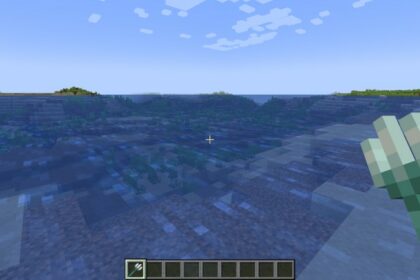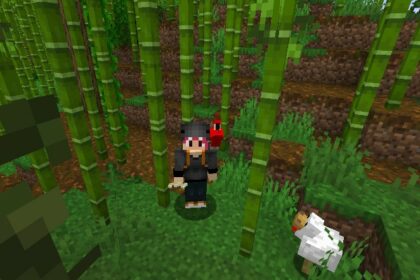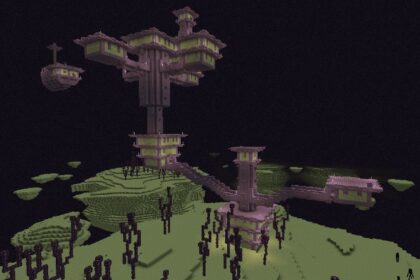In Minecraft, you can go above and beyond in terms of combat; the game allows you to use weapon enchantments, combat potions, food effects, etc.
Additionally, one of Minecraft’s most exciting combat blows is conjuring a lightning strike on something.
Smiting a player or mob in Minecraft might not be enough to kill it, but the lightning blow can cause a great deal of damage and confusion to anyone who receives it. Still, do not rely solely on this combat trick when dueling.
Minecraft has two meanings for smiting; the first is the weapon enchantment “smite”, which causes an effect upon undead and skeleton mobs; the second is the general meaning of striking someone or something with a lightning bolt.
In this article, we’ll cover the second meaning. Now, let’s discuss how to smite someone in Minecraft.
There are a few methods of smiting players and mobs in Minecraft; let’s discuss each technique and how some can be more appropriate than others depending on the gameplay context.
Trident Channeling
One of the most conventional methods of striking players and mobs with a lightning blow is to acquire a trident and enchant it with one of its exclusive enchantments, the “Channeling”.
First, you’ll need to acquire a trident. Tridents are weapons that fit both into the melee and ranged categories; the only way to get them is by slaying a trident-wielding “drowned”.

Even so, prepare to slay a few of these mobs since a trident-wielding drowned has a 3% chance of dropping the weapon.
Although this type of weapon is pretty scarce in Minecraft, you can attempt to create a drowned farm mechanism to increase your chances of looting a trident. The high quantity of drowned will increase the chances of having a few trident-wielding ones.
After acquiring a trident, head towards an enchanted table to try and add the “channeling” perk into the weapon.
This enchantment will give your trident the power to conjure a lightning strike whenever it hits a mob.

You can also combine enchanted books with the “channeling” enchantment with a trident through an anvil.
You’ll need to throw your trident at a mob while standing in the rain to make it work; if you’re in a dry region, the lightning won’t occur. Consequently, you’ll smite players and mobs with the trident.
A common downside of throwing tridents in Minecraft is that you’ll need to grab them back off the ground. For this reason, enchanting the trident with the “Loyalty” perk is also recommended since this enchantment makes the weapon instantly return to your hands.
Beware that enchanting a trident with the channeling perk makes it impossible to add the “Riptide” enchantment since they’re mutually exclusive.
Thunderstorms
Using the game’s weather is a unique and more challenging method of ensuring someone gets smote in Minecraft. Thunderstorms are temporary occurrences that might happen anytime in the overworld dimension.
You can spot thunderstorms by this condition’s visual changes in the world’s presentation. For example, a thunderstorm causes the sky’s light level to decrease to 10, turning the day significantly darker; you’ll notice grayer clouds, and the sun won’t be visible anymore.
Consequently, hostile mobs will spawn at any time of the day.

There’ll be a fair occurrence of lightning in thunderstorms.
A bolt of typical thunderstorm lightning causes a small 2-block blast, where a fire will start on the affected blocks. Although the lightning causes damage to players and mobs, it does not destroy anything.
The lightning causes up to five health points to any entity it strikes. There’s a chance of lightning strikes falling in succession, causing damage to up to 10 health points. In addition, after the lightning’s first contact with the mob, a fire starts, causing gradual damage.
Using this weather condition, you can lead players and mobs into thunderstorms in hopes of smiting or confusing them.
Using Commands
You can also use specific commands while in-game to cause lightning strikes. For instance, typing down “/summon lightning_bolt” on the text bar with cheats enabled summons a lightning strike as an entity. You can refer to it by commands or selectors.
You can specify the coordinates in which you want the lightning bolt to strike. For example, if there’s a player on the x = 123 Y=40 and Z=756 coordinates, you’ll want to type in:
- /summon Minecraft:lightning_bolt 123 40 756
The text format should always follow the X – Y – Z order.

In some versions of Minecraft, the syntax to summon the lightning bolt might be “/summon LightningBolt” without the underline.
So, if you find out a player’s coordinates, you can quickly smite them with the text command above.
Lightning Rod
Alternatively to the trident, which is an in-game asset that conjures lightning bolts, you can also use a lightning rod, which does the same but through a different mechanism.

When raining during thunderstorms, the lightning rod attracts thunderbolts to itself.
As in real life, this item is helpful to neutralize the risks of lightning strike fire in a particular region. You can craft it and place it somewhere on the ground to use it. The crafting blueprint is:

Any mob or player standing on the lightning rod will be at risk of getting struck by lightning. Therefore, if you manage to push or persuade someone to stay above it, you’ll be able to smite them indirectly.
Usage of Lightning Strikes
In Minecraft, lightning does not only offer a visual spectacle or physical damage when striking a mob. Instead, Minecraft’s lightning strikes can hit a mob and cause a particular type of change in its behavior.
For instance, there are about five distinctive effects lightning bolts cause when contacting individual mobs. These effects are:
- Turning a pig into a zombified piglin.
- Turning a creeper into a charged creeper.
- Turning a villager into a witch.
- Turning a red mushroom into a brown mushroom and the other way around.
- It instantly kills turtles but makes them drop bowls upon death, which is not their usual loot.
In this sense, if you throw a channeled trident on any of the mobs mentioned above during rainy weather, you’ll cause a particular effect on them. In the case of a villager, it will turn into a witch, prompting it to attack you immediately.






